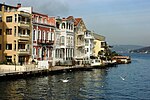Bosporus

The Bosporus or Bosphorus Strait ( BOSS-pər-əs, BOSS-fər-əs; Turkish: İstanbul Boğazı, lit. 'Istanbul strait', colloquially Boğaz) is a natural strait and an internationally significant waterway located in Istanbul, Turkey. The Bosporus connects the Black Sea to the Sea of Marmara and forms one of the continental boundaries between Asia and Europe. It also divides Turkey by separating Anatolia from Thrace. It is the world's narrowest strait used for international navigation. Most of the shores of the Bosporus Strait, except for the area to the north, are heavily settled, with the city of Istanbul's metropolitan population of 17 million inhabitants extending inland from both banks. The Bosporus Strait and the Dardanelles Strait at the opposite end of the Sea of Marmara are together known as the Turkish Straits. Sections of the shore of the Bosporus in Istanbul have been reinforced with concrete or rubble and those sections of the Strait prone to deposition are periodically dredged.
Excerpt from the Wikipedia article Bosporus (License: CC BY-SA 3.0, Authors, Images).Bosporus
İskele Sokak,
Geographical coordinates (GPS) Address Nearby Places Show on map
Geographical coordinates (GPS)
| Latitude | Longitude |
|---|---|
| N 41.119444444444 ° | E 29.075277777778 ° |
Address
Yeniköy Şehir Hatları İskelesi
İskele Sokak
34464 , Yeniköy Mahallesi
Turkey
Open on Google Maps




